Last Updated on November 28, 2025
Purchase Requisition and Purchase Order
Are you confused about the concept of purchase requisition vs. purchase order? You’re not alone. It’s a common mix-up, but don’t worry; we’re here to help. This guide explores the varied facets of PRs and POs and why knowing the difference is important. We’ll cover everything from the basics of each document to their role in the procurement process.
Keep reading to learn more about purchase requisition vs. purchase order and how they can help you understand your procurement process more comprehensively.
Preparing a purchase requisition (PR)
Here are all the details you need to know before preparing a purchase requisition.
What is purchase requisition (PR)?
A purchase requisition is a document that you can use to request the purchase of goods or services from a vendor. The procurement department initiates it to buy something that is not available.
Using a purchase requisition order helps ensure proposed purchases are made in a controlled and organized manner, with appropriate oversight and accountability. It also prevents unauthorized or unnecessary spending and facilitates tracking and reporting procurement activities.
Also, Read: Purchase Order vs Invoice
What is the purpose and importance of a purchase requisition (PR)?
The purpose of a purchase requisition form is to provide a structured and formal process for requesting and authorizing the purchase process. Here are some key reasons why a PR is important:
1. Control
It prevents unauthorized or unnecessary spending and ensures purchases are aligned with the organization’s goals and objectives.
2. Accountability
Organizations can establish clear accountability for procurement activities to ensure purchases comply with relevant policies and regulations. Furthermore, any issues or concerns can be addressed timely.
3. Efficiency
A PR helps streamline procurement system by providing a standardized format for requesting and approving purchases. It reduces delays and errors and facilitates tracking and reporting of procurement activities.
4. Budgeting
A PR ensures expenditures are aligned with the organization’s overall financial plan by including the budget or cost center charged for the purchase. It prevents overspending or underfunding of important initiatives.
Related Read: Budgeting and Forecasting: The Definitive Guide
Who creates purchase requisitions?
Purchase requisitions are usually created by individuals or departments within an organization. The specific roles and responsibilities for creating PRs may vary depending on the organization, but here are some examples of who might be involved:
1. Employees
Employees might create a PR to request office supplies or equipment needed to perform their job.
2. Department managers
A department manager might create a purchase request for specialized software, hardware, or services needed to support their team’s work.
3. Project managers
A project manager might create a PR to request resources or materials needed to complete a specific project.
4. IT Staff
IT staff might create a PR to request hardware or software needed to support the organization’s technology infrastructure.
Recommended Read: Centralized Purchasing vs Decentralized Purchasing
Purchase requisition workflow
- Create PR
- Review PR
- Review budget
- Approve PR
- Create PO
- Send PO
- Receive goods/services
- Approve invoice
- Pay supplier
- End
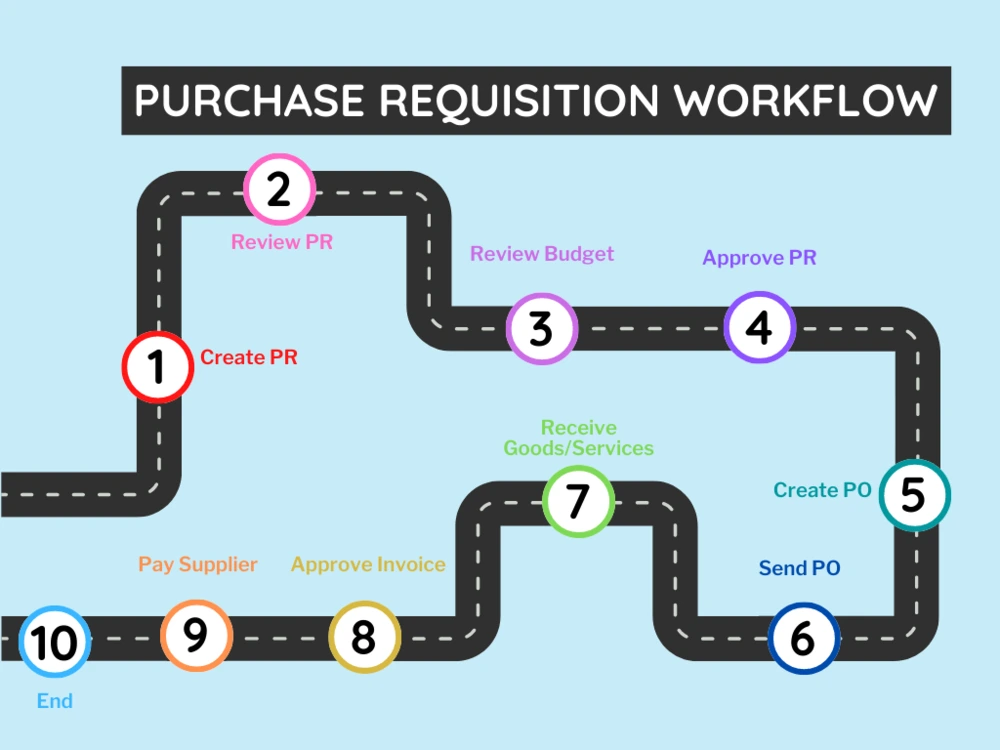
How does purchase requisition work?
Here are the steps involved in a purchase requisition process:
1. Identify need
The requester identifies a need for goods or services currently unavailable.
2. Create PR
The requester creates a purchase requisition (PR) document that includes details about the requested goods or services.
3. Review PR
The requester’s manager, who may approve or reject the request, reviews the PR. If additional information or approvals are required, the PR may be sent back to the requester for revision.
4. Review budget
The finance team reviews the PR to ensure the request is within budget and complies with financial regulations.
5. Approve PR
The finance team approves the PR.
6. Create PO
The purchasing team creates a purchase order (PO) based on the information in the PR.
7. Send PO
The PO is sent to the vendor to initiate the procurement process.
8. Receive goods/services
The supplier delivers the goods or services specified in the PO.
9. Approve invoice
The requester reviews the supplier’s invoice to ensure it matches the PO and the goods or services received. If there are any discrepancies, the requester may work with the supplier to resolve them.
10. Pay supplier
The accounts payable team pays the supplier based on the terms of the PO and negotiated payment arrangements.
Also, Read: Sourcing vs Procurement: Key Differences
Key information to include in a PR
Here are some of the most important details that should be included in a PR request form:
- Description of goods/services: Add a clear and detailed description of the requested goods or services, including any relevant specifications or requirements.
- Quantity: Specify the quantity of goods or services needed.
- Delivery date: Include the desired delivery date or timeframe for the goods or services.
- Price: Add an expected price for the goods or services being requested.
- Budget code: Share the appropriate budget code or account number for the purchase.
- Approval process: Outline required approvals, like approval from the requester’s manager or the finance team.
- Vendor information: If a specific vendor has already been identified, the PR should include the following information: vendor’s name and contact details.
- Other requirements: Include other requirements or special instructions related to the purchase, like delivery location or payment terms.
Quick Read: What is Source to Pay (S2P)?
Preparing a purchase order (PO)
Here’s everything you need to know before preparing a purchase order:
What is a purchase order (PO)?
A purchase order (PO) is an external document a buyer sends to a supplier to initiate the procurement process. It includes details about the goods or services being purchased, the quantity, description, price, delivery date, and other relevant terms or conditions.
The PO acts as a legally binding contract between the buyer and supplier, outlining the specific details of the transaction and providing a record of the agreed-upon terms. Creating a PO ensures the supplier understands the requested goods or services and can begin working on fulfilling the order.
What is the purpose and importance of a purchase order (PO)?
The PO is a critical component of the procurement process, providing a formal mechanism for initiating and managing purchases of goods and services. Here are some reasons why using a PO is important.
1. Formalizes the transaction
A PO creates a legal and binding agreement that outlines the purchase details.
2. Provides clarity
The PO specifies the goods or services purchased, including the quantity, description, price, and delivery date.
3. Ensures accountability
The buyer can ensure the supplier is accountable for delivering the requested goods or services according to the agreed-upon terms.
4. Facilitates communication
The PO is a communication tool between the buyer and supplier, helping ensure both parties understand the transaction clearly. It also provides a platform for both parties to resolve any issues or discrepancies.
5. Streamlines procurement process
The PO streamlines the procurement process, providing a standardized and efficient mechanism for managing purchases of goods and services.
Also, Read: Top 10 Procurement KPIs
Who creates a purchase order?
In most organizations, the procurement or purchasing department creates purchase orders. However, depending on the size and structure of the organization, other individuals or departments may also be involved in the PO creation process.
Here are some examples other than the procurement/purchasing department:
- Department managers: In some organizations, department managers may be authorized to create purchase orders for goods or services needed by their department.
- Project managers: If a purchase is related to a specific project, the project manager may be responsible for creating the purchase order.
- Finance team: The finance team may be involved in creating or approving purchase orders, particularly if there are budgetary constraints or other financial considerations.
Suggested Read: What is Spend Analysis: The Ultimate Guide for Procurement
Purchase order workflow
- Purchase requisition approval
- Purchase order creation
- PO review and approval
- PO submission to supplier
- Supplier acknowledgment of PO receipt
- Order fulfillment and shipment
- Receiving and inspection of goods/services
- Payment processing
- PO record keeping and archiving
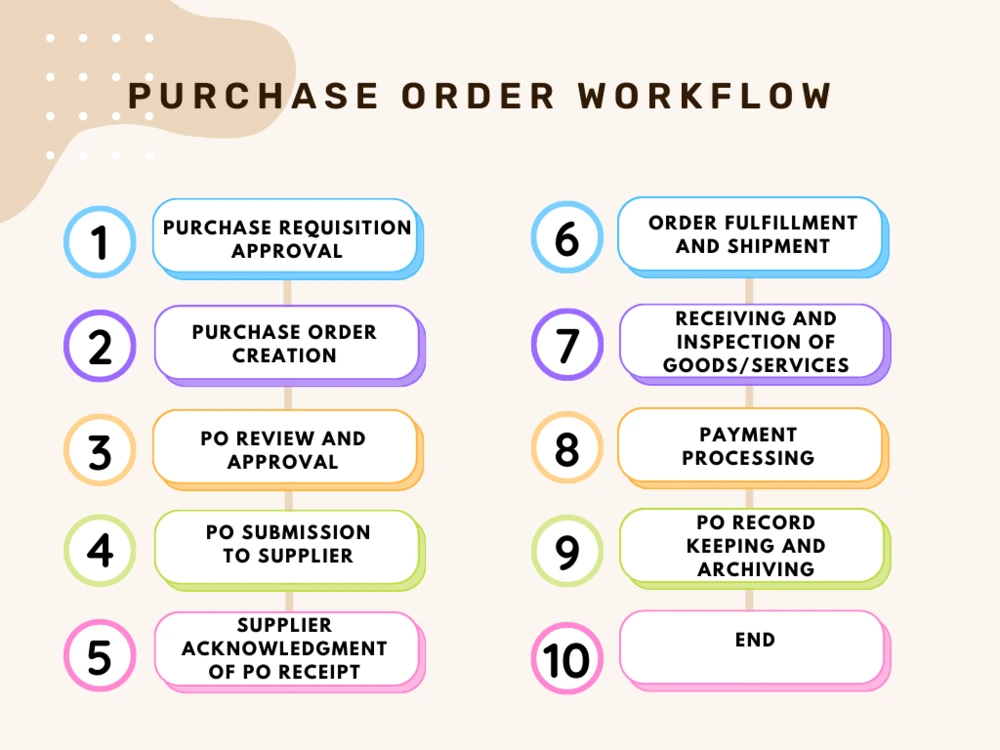
How does a purchase order work?
Here are some key steps involved in the purchase order process:
1. Purchase requisition
A purchase requisition is submitted to the procurement department, typically by a department manager or authorized individual.
2. Purchase order creation
The procurement department creates a purchase order based on the information in the purchase requisition.
3. PO review and approval
The PO is reviewed and approved by the purchasing manager, finance team, or others involved in the procurement process.
4. PO submission to supplier
The approved PO is submitted to the supplier for further action.
5. Supplier acknowledgment
The supplier acknowledges receipt of the PO and confirms they can fulfill the order according to the terms outlined.
6. Order fulfillment and shipment
The supplier fulfills the order and ships the goods or provides the requested services.
7. Receiving and inspection
The buyer receives the goods or services and inspects them to ensure they meet the specifications.
8. Payment processing
The buyer processes payment to the supplier according to the agreed-upon terms.
9. PO record keeping
The buyer records the PO and associated key documents for future reference and financial audits.
Quick Read: Purchase Order Automation Process
Key information to include in a PO
Here are some key pieces of information that should be a part of the purchase order form:
- Purchase order number: Add the correct PO number in the designated space. Accurate numbering ensures seamless recordkeeping and audit management.
- Company information: Include the name, shipping address, and contact information of the buying company.
- Supplier information: Include the name, address, and contact information of the supplier.
- Order details: Add a detailed description of the purchased goods or services, including quantity, price, delivery date, and terms and conditions.
- Payment terms: Specify the payment terms, including the payment method and due date.
- Shipping and delivery information: Add details about shipping and delivery, including the method of shipment and delivery address.
- Applicable taxes and fees: State any applicable taxes and fees associated with the purchase.
- Terms and conditions: Include relevant terms and conditions for the purchase, like warranties and return policies.
Also, Read: What Is Spend Analytics in Procurement?
Purchase requisition vs. purchase order: Which one should you use and when?
Here’s a detailed look at the suitability of purchase requisition vs. purchase order depending on circumstances.
Scenarios where a purchase requisition is appropriate
Here are some scenarios where a purchase requisition would be appropriate:
- Requesting new equipment (computers or machinery)
- Ordering supplies (paper or printer ink)
- Hiring Services (consulting or marketing services)
- Travel and Entertainment: (employees travel for work/client meetings)
- Capital Expenditures (purchasing a new building or investing in new equipment)
Scenarios where a purchase order is appropriate
Here are some situations where a purchase order would be appropriate:
- Ordering goods (raw materials or inventory management)
- Hiring contractors (service providers for specific projects or services)
- Subcontracting (subcontracting some of the work to another company)
- Outsourcing (IT or customer service functions)
- Consulting services (legal or accounting services)
Recommended Read: What is P2P Cycle: Procure-to-Pay Process
Difference between purchase requisition vs. purchase order (PR vs. PO)
Purchase requisitions and purchase orders are important internal documents used in procurement, but they serve different purposes. Here are some key differences between purchase requisition vs. purchase order:
Purchase requisition |
Purchase order |
|
|
Purpose |
Request goods or services |
Place an order for goods or services |
|
Issued by |
Employees or departments |
Procurement department or buyer |
|
Approval process |
Requires approval from higher-ups |
Approved purchase requisition is used to generate a purchase order |
|
Legal obligation |
No legal obligation to purchase |
Legally binding agreement between buyer and supplier |
|
Details included |
General information about the purchase |
Specific details about the goods or services to be purchased, including price, quantity, and delivery date |
PR to PO process
Let’s take a look at the entire PR to PO process.
What is the PR to PO process?
The PR to PO process involves converting a purchase requisition into a purchase order. It then becomes a legally binding agreement between the buyer and the supplier.
The PR to PO process typically involves the following steps:
1. Reviewing the purchase requisition
The procurement department reviews the purchase requisition to ensure it meets all the requirements and has a sufficient budget for the purchase.
2. Obtaining quotes or bids
The procurement department should obtain quotes or bids from potential suppliers to determine the best price and terms for the purchase.
3. Creating the purchase order
Once a supplier has been identified, the procurement department creates a purchase order with specific details about the goods or services to purchase.
4. Review and approval
The purchase order is then reviewed and approved by the department manager.
5. Issuing the purchase order
Once the purchase order is approved, it is issued to the supplier.
Quick Read: How to Form a Successful Procurement Plan?
Importance of PR to PO process
The PR to PO process plays a crucial role in procurement and is essential for organizations that want to streamline their purchasing operations. Here are some reasons why the PR to PO process is crucial:
1. Control over purchasing
It ensures all purchases are made in an organized manner with necessary approvals before any purchase is made.
2. Budget management
The process allows for better budget management by requiring review and approval of purchase requisitions and ensuring purchases are within budget.
3. Reducing errors
It helps reduce errors by accurately recording the purchase order’s details, like quantity, price, and delivery date.
4. Legal protection
It is a legally binding agreement applicable to both buyer and the supplier, protecting both parties in case of any disputes.
5. Better supplier relationships
The process allows for better communication with suppliers, specifying the required goods or services, delivery dates, and payment terms.
Also, Read: What is budgeting in business?
PR to PO process flow chart
The PR to PO process involves several crucial steps for making purchases efficiently and effectively. Here’s a look at them.
- Requisition
- Approval
- Purchase Order Creation
- PO Approval
- Purchase
- Receipt and Invoice Matching
- Payment
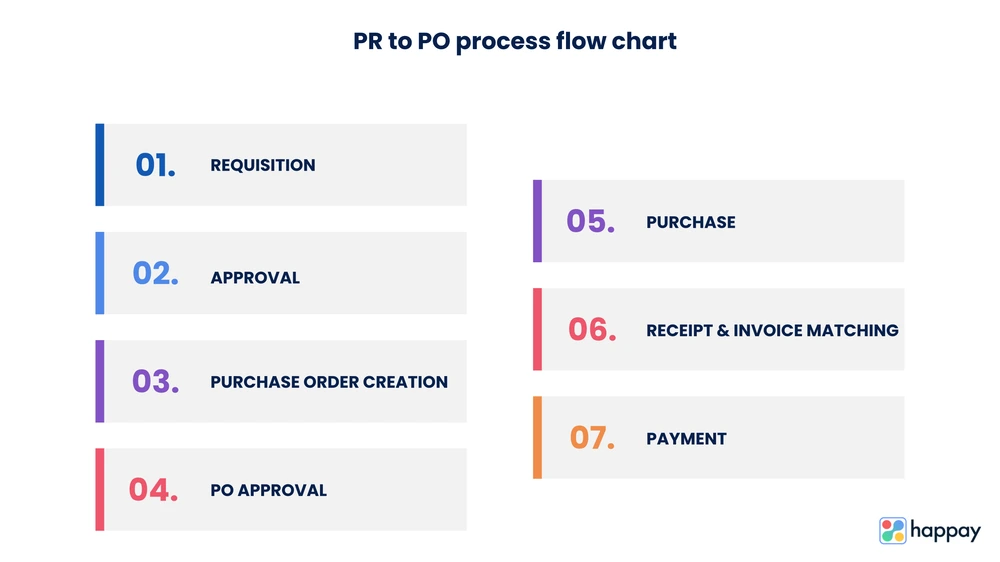
Steps involved in converting a purchase requisition to a purchase order
Converting a purchase requisition (PR) to a purchase order (PO) involves the following steps to ensure the purchase is made efficiently:
- Step 1: Review the PR
The first step involves reviewing the item description, quantity, budget code, and delivery date. It ensures the PR aligns with organizational policies and budget constraints.
- Step 2: Select a supplier
Selecting a suitable supplier involves evaluating potential suppliers based on price, quality, delivery time, and reputation.
- Step 3: Create a PO
Creating a PO includes adding details like the supplier’s name, item description, price, quantity, and delivery date.
- Step 4: PO approval
The PO is reviewed and approved by authorized personnel to ensure all details are accurate.
- Step 5: Purchase
The supplier receives the PO and delivers the goods or services as specified.
- Step 6: Receipt and invoice matching
The receiving department checks the delivered goods or services against the PO to ensure they match and there are no discrepancies. The accounting department then matches the supplier’s invoice against the PO and receipt to ensure accurate payment.
- Step 7: Payment
The supplier is then paid for the delivered goods or services per the payment terms.
Purchase requisitions (PR) Approval
Let’s now look at how the purchase requisition approval process works.
Importance of purchase requisitions approval
Purchase requisition (PR) approval is an essential component of the procurement process as it guarantees purchases are made in a compliant manner. It ensures all procurement activities follow the correct policies and procedures and are consistent with the company’s objectives.
The approval process typically involves the requester, department head, and finance team, which helps reduce the risk of fraud and ensure accountability.
PR approval is also vital to ensure the company obtains the best value for money when purchasing. It ensures all purchases are necessary and the goods or services are procured from reliable suppliers at competitive prices. In addition, PR approval helps to maintain accurate records of all procurement activities.
Also, Read: 5 Steps to Automate Your Expense Approval Process
Who approves a purchase requisition?
The approval of a PR involves several individuals or departments, depending on the organization’s hierarchy and policies. Usually, the requestor initiates the PR and submits it to their supervisor or department head for approval. The department head then reviews the request and forwards it to the finance team for further scrutiny.
The finance team examines the PR to ensure it aligns with the organization’s budget constraints and procurement policies. If the PR is within the budget and complies with the procurement policies, the finance team approves it and sends it to the purchasing department for processing.
The purchasing department then converts the approved PR into a purchase order (PO) and forwards it to the supplier. Sometimes, the approval process may involve additional authorization levels, such as senior management or a designated procurement team, depending on the organization’s structure and purchasing policies.
What happens if a purchase requisition is not approved?
If a purchase requisition PR is not approved, the requestor may need to revisit the request and make adjustments to address the concerns. The reasons for rejecting the PR could be due to the unavailability of funds, the purchase being outside the scope of the procurement policy, or inadequate information.
The requestor may need to provide additional details or justifications for the purchase and resubmit the PR for approval. Alternatively, if the PR is rejected due to budget constraints, the requestor may need to explore alternative options.
These include seeking alternative suppliers or purchasing lower-cost alternatives. It’s important to have a well-defined PR approval process to prevent rejections or delays in the procurement process.
Quick Read: 10 Best Business Management Software
Purchase order (PO) approval and issuance
Let’s now look at the approval and issuance process of POs.
Importance of purchase order approval and issuance
The approval process for POs involves a review by multiple parties, including the procurement team, the finance department, and the department that requested the purchase. Once the PO is approved, it is issued to the supplier, who is contractually obligated to fulfill the terms and conditions in the document.
The process ensures purchases comply with the organization’s procurement policies and procedures. It includes requirements such as obtaining competitive bids or ensuring that purchases fall within budget limits. Furthermore, the process establishes a clear transaction record, which can be critical if disputes or issues arise with the supplier.
Who approves a purchase order?
The first person who usually approves the PO is the purchasing officer. They verify that the PO complies with company policies, procedures, and budgets.
Afterward, the PO goes through a series of approvals based on the value of the purchase and the organization’s hierarchy. The PO may need approval from the department head, finance or accounting department, and senior management.
The department head ensures that the items ordered align with the department’s needs, while the finance or accounting department verifies that sufficient funds are available to cover the purchase. Obtaining approvals from multiple stakeholders ensures the purchase is necessary, feasible, and aligned with the organization’s goals.
Also, Read: The Business Guide to Vendor Management System
What happens if a purchase order is not approved?
If a purchase order is not approved, it may cause delays in the procurement process. It will ultimately impact the delivery of goods or services. The supplier may not fulfill the order until they receive a valid purchase order, which can result in further delays.
Additionally, non-approved purchase orders can create confusion and potential disputes between the purchasing department and the supplier.
It is thus crucial to ensure purchase orders are approved timely to avoid disruptions. When a purchase order is not approved, it may need to be revised or canceled, and the approval process would need to start again.
Automating purchase requisition vs. purchase order approval with technology
Procurement software allows purchase requisitions and purchase orders to be automatically routed to the appropriate approvers for review and approval. It saves time and decreases the likelihood of errors or delays in the approval process.
Several procurement software options in the market offer for automating purchase requisition and purchase order approval features. Here are some of the best options:
- SAP Ariba
- Coupa
- Oracle Procurement Cloud
- Procurify
- Jaggaer
- Zycus
Tips for choosing the best software for purchase requisition vs. purchase order automation
Here are some tips to help you choose the best software for your organization:
- Identify your specific needs: Different organizations have different procurement needs for their process automation. Identify your workflow management, supplier management, and reporting to choose software that meets business needs.
- Look for user-friendly software: The software should be simple to use and have a user-friendly interface. Your employees can use it without extensive training.
- Consider integration capabilities: The software must integrate with your existing systems, like ERP and accounting.
- Check for customization options: Look for software that you can customize to meet your unique needs. It will allow you to tailor the software to your business processes.
- Evaluate customer support: Ensure the software vendor provides adequate customer support to resolve issues during implementation.
Also, Read: 10 Best Financial Management Tools
Purchase requisition vs. purchase order: Bottom line
Understanding the difference between purchase requisitions and purchase orders is crucial for any business or organization that engages in procurement activities. While both documents play an essential role in the procurement process, they serve different purposes and are used at different stages.
Implementing best practices for their approval and issuance will help you streamline your procurement processes, reduce errors and delays, and ultimately achieve greater efficiency and cost savings. With the help of procurement software, the automation of these processes can be even more beneficial.
FAQs
The four types of purchase orders are standard, planned, blanket, and contract.
The seven steps of the requisition procedure are identifying the need, creating a requisition, approving the requisition, creating a purchase order, approving the purchase order, receiving the goods/services, and reconciling the invoice.
Yes, the purchase requisition comes before the purchase order. The requisition form helps move the process toward creating a purchase order.
PR approval is the process of approving a purchase requisition, while PO approval is the process of approving a purchase order.
Yes, a purchase requisition is usually mandatory in the PO process as it is the document that initiates the procurement process.
Yes, in some cases, a PO can be created without a PR, such as in emergencies or for recurring orders.
The number of days required for a PR approval can vary depending on the organization’s procurement process and the complexity of the request.
To go from PR to PO, the PR must be approved, and a PO must be created with the information in the PR.
The PO cycle in PR refers to the entire procurement process, from identifying the need for goods or services, creating a requisition, getting approval, creating a purchase order, receiving the goods or services, and reconciling the invoice.


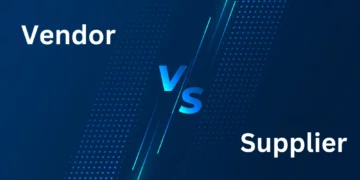



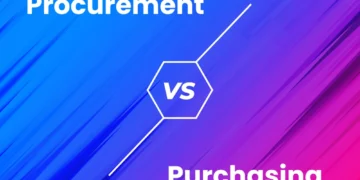



Discussion about this post